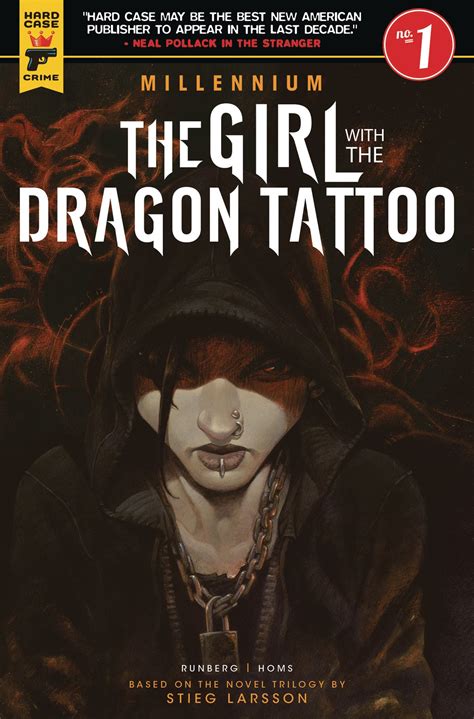What is Vertigo Comics The Girl with the Dragon Tattoo Book 1?

The Girl with the Dragon Tattoo Book 1 is an adaptation of Stieg Larsson's novel, which was specifically created for the Vertigo Comics series. The story revolves around Mikael Blomkvist, a journalist who is fighting to save his reputation after a legal battle. In response, he receives an offer from Henrik Vanger, a retired CEO, to investigate the unsolved disappearance of Vanger's niece, Harriet.
As Mikael delves into the case, he is joined by Lisbeth Salander, a brilliant young hacker with a mysterious past. Lisbeth is the titular character of the series, and her sharp wit and resourcefulness make her an indispensable ally to Mikael in his investigation.
The comic book adaptation stays true to Larsson's original novel, with vivid illustrations that bring the characters and settings to life. The artwork is gritty and detailed, capturing the dark themes of the story and the bleak atmosphere of the Swedish countryside.
The Girl with the Dragon Tattoo Book 1 is a gripping read that will keep you on the edge of your seat from start to finish. It's a must-read for fans of the original novel, and even for those who have never read it before. The Vertigo Comics adaptation offers a fresh take on the story, bringing it to a new audience while staying true to the spirit of Larsson's work.
Frequently Asked Questions about vertigo comics the girl with the dragon tattoo book 1
A spellbinding amalgam of murder mystery, family saga, love story, and financial intrigue. It's about the disappearance forty years ago of Harriet Vanger, a young scion of one of the wealthiest families in Sweden . . . and about her octogenarian uncle, determined to know the truth about what he believes was her murder.
No, The Girl with the Dragon Tattoo is not a true story. However, Stieg Larsson gained his inspiration from real events. When he was fifteen, he stood by as a girl he knew named Lisbeth was gang-raped. He did not have the courage to intervene then, and this event continued to haunt him as an adult.
DC Comics/Vertigo will publish the official graphic novel adaptation of Stieg Larsson's "Millennium Trilogy," starting in Fall 2012 with THE GIRL WITH THE DRAGON TATTOO, the international publishing phenomenon. Each book in the "Millennium Trilogy" will be adapted in two hardcover graphic novel volumes.
Stieg Larsson's 3 Book Set: The Girl with the Dragon Tattoo, The Girl Who Played with Fire, The Girl Who Kicked the Hornet's Nest, 3 Full-Size Books: Books 1 and 2 are Paperbacks, Book 3 is a Hardcover.
In China, Japan and Vietnam in particular, dragons have a rich history, making them highly regarded mythical creatures. Often representing wisdom, freedom, and strength, an Eastern-style dragon tattoo is a symbol of power. In contrast, in Europe, dragons were considered evil creatures to be slayed.
Some of the moral and ethical issues in The Girl with the Dragon Tattoo are straightforward: Nazism = bad; murder, rape, torture, physical abuse = bad; global financial fraud and organized crime = bad.
I was pleasantly surprised, then, to discover it is neither formulaic nor disturbingly graphic. And it was indeed Larsson's take on feminism that made it stand out as an original read. The book promotes a very Scandinavian sort of equality. The message I took from it was that gender is irrelevant.
While it is never explicitly stated, Salander seems aware of her own autistic tendencies. She exists on a spectrum, never clearly diagnosed nor labelled, though Mikael Blomkvist speculates that she may have Asperger Syndrome. This lack of definition is liberating, in a sense.
The biggest example of gender-based violence that occurs in the films is the rape scene between Salander and Burjmann. The first attack, Burjmann against Salander, is immediately sexual in nature. Salander even expects it, she brings a camera for blackmail.
I was pleasantly surprised, then, to discover it is neither formulaic nor disturbingly graphic. And it was indeed Larsson's take on feminism that made it stand out as an original read. The book promotes a very Scandinavian sort of equality. The message I took from it was that gender is irrelevant.
Dragons in Chinese culture symbolize great power, good luck and strength. They represent power and authority, particularly control over typhoons, water, rainfall and floods. Emperors were assumed to have descended from the dragons. That is why, out of the twelve zodiac signs, the Dragon is the most popular one.
All in all, Japanese dragons are the benefactors and protectors of mankind; powerful and wise guardians that shield us from universal dangers, and impart their wisdom. A symbol of good fortune, they bring us happiness, offering us strength and courage at each important turning point in our lives.
She is physically violent and seemingly without empathy or remorse. There appear to be no real relationships in her life, causing some viewers (and Blomkvist himself) to wonder if she has Asperger's syndrome. Her lack of interpersonal relationships and odd persona have suggested schizoid personality disorder to some.
As the novel ends, Blomkvist writes an expose about the Wennerström affair that upends the financial world, restores his credibility, and reestablishes Millennium's security. Salander assumes a fake identity and drains several of Wennerström's accounts in order to secure financial independence in the future.
Peter Teleborian describes her as "paranoid", "psychotic", "obsessive", and an "egomaniacal psychopath". On the other hand, Larsson stated that he thought that she might be looked upon as something of an unusual kind of sociopath, due to her traumatic life experiences and inability to conform to social norms.
Jane Austen's novels are not feminist in the way we mean it today. But they do hint at the need for equality between the sexes. Her heroines defy gender norms, and push for more agency in their own lives. The overarching theme that runs throughout all her novels is the inequality faced by women in Regency society.














